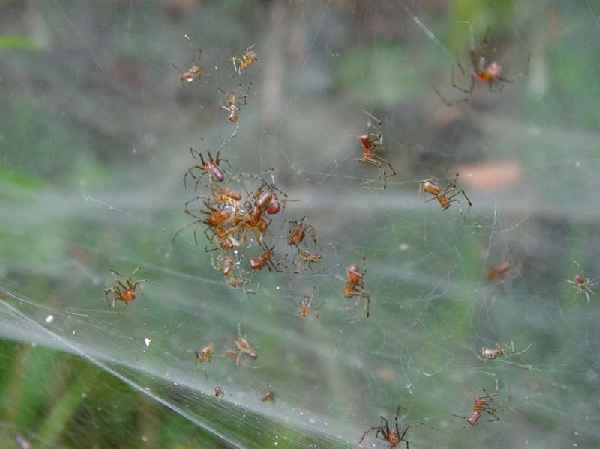Social Spiders
Austen Brown and Jenny Eng
Ontogeny
Ontogeny is the study of development, and often focuses on the interplay of genetic and environmental factors in shaping a behavior. In general, spiders hatch from an egg sac containing numerous eggs, undergo a series of molts in which they shed and re-grow their exoskeleton, and eventually reach sexual maturity. The period between molts is called an instar, and is typically identified by a number. Throughout its lifetime, a social spider will undergo behavior transformations equal to its striking morphological alerations. The ontogeny of social behavior can focus narrowly on the development of behavior over a single individual’s lifetime, or widely on the changing dynamic of group behavior through time.

Anelosimus eximius. Image taken from Reference 2
Foraging
As young spiders mature and grow larger in relation to their prey, we might expect them to undergo changes in foraging behavior. Philoponella sp. of the family Uloboridae, a social spider that inhabits wet lowland forests in southern Cameroon, exhibits some age-specific foraging behaviors (7). When an insect is caught in the web and struggling, many spiders will cooperate to bind the animal. In this situation, younger spiders will throw silk from above, while adults and large juveniles will station themselves in the apparently more dangerous position below the animal (7). Young spiders also avoid ensnared mantids, able to identify the danger of these aggressive insects (7).
Dispersal
Although permanently social (quasisocial) spiders do not leave their natal nests, closely related subsocial spiders do disperse, exhibiting cooperative behaviors until they are fully mature and then dispersing for mating. Studies on the factors affecting dispersal are important to understanding permanently social spiders because they illuminate the selective pressures associated with leaving or staying in the natal nest.
A study of Anelosimus studiosus, a subsocial spider in the same genus as the most studied quasisocial spider species, A. eximius, examined the effect of prematurely removing offspring from their nests (6). On average, control animals that were left in their nests survived longer, developed faster, and enjoyed more resources per individual (6). While those that were removed did worse as a group, individuals were occasionally able to subdue prey unaided, and in these cases enjoyed a 10-fold abundance of food compared to the colony-living control group (6). This risky opportunity for a big pay-off explains the observation of some wild sub-adult females living solo; in colonies with too much competition for food, early dispersal becomes a more promising option, and these juvenile females have taken the gamble (6). The observed variation in dispersal of subsocial spiders suggests that the behavior is highly environment dependent, with individuals making desicions based on their specific situation. Additionally, the negative effects of experimental manipulation of dispersal confirms that the environment exerts considerable selective pressure that delays the dispersal of most subsocial spiders.
Colony Development
In addition to changes apparent on the level of the individual, we can observe deveopments in the composition of the colony as a whole. Most often studied is the ontogeny of age structure. Social spider colonies commonly contain several distinct generations living together. In one study a colony of Anelosimus rupununi, a quasisocial spider from Ecuador, was observed for eighteen weeks (5). At the beginning of observations, the colony contained mostly subadult females and no egg sacs (5). In six weeks these spiders matured and laid egg sacs (5). At week 10 the spiderlings hatched, while the adult females began to decline (5). All the orginal adult females were gone by the time their offspring reached the subadult stage (5). Males of this species are much shorter lived, disappearing even before egg sacs hatch (5). Such synchorinization of generations is integral to social behavior, which relies on a critical mass of like-aged spiders to care for egg sacs.